The Puget Sound Coast Artillery Museum at Fort Worden.
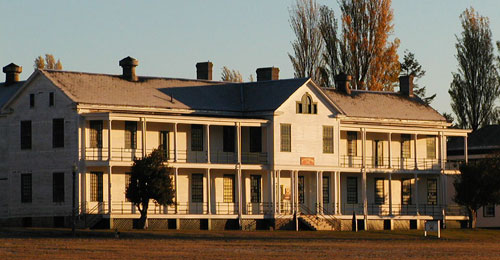
This section is still being written, so there will be additions and changes when I have time to work on it.
We have some photo albums available, and will add more as we have time, not every listing on this page has an album yet. Click on the thumbnail image in each section to open the photo album if it's available. The number of photos in the album is listed, some of the albums are quite large. There are four sections so far:
Historical information,
Clearing projects Painting projects and Construction Projects (nothing there yet). Corrections and additional information are always welcome, please
<email> us.
Historical information about parts of the Fort:
Harbor Defenses of World War II at Fort Worden
As the war heated up in Europe in the late 1930s and early 1940s the US began upgrading and strengthening its military. Part of the upgrading included establishing Defense Command operations for major harbors in the Country. On June 23, 1940 a memorandum was issued discussing the duties of the Harbor Defenses. For a great deal of additional information about the Harbor Defense systems of WWII, see the 1974 Report prepared by the National Parks Service and referenced at footnote 1
From page 7 of the National Park Service report:
The HECPs were to be the central point for coordination and joint operation of Army and Navy elements of the harbor defense system whose mission was to: (a) "collect and disseminate information of activities in the defensive sea area"; (b) to control "unescorted commercial shipping in the defensive coastal areas"; and (c) to take prompt and decisive action "to operate the elements of the harbor defense," to deny enemy action within the defensive coastal area.
Each of the posts was "visualized" as being continuously manned by "an officer of both the Army and Navy and the necessary assisting personnel for clerical and communication duties, where the Army and Navy officers are the Senior Local Commanders of their respective services, or their direct representatives with authority to take the action necessary to accomplish the mission."
The Harbor Defense facilities at Fort Worden were one of about 18 similar facilities constructed at major harbor entrances around the country. Some were constructed simply by remodeling existing structures and went online pretty quickly. This was done temporarily at Fort Worden, but the two primary buildings at Fort Worden were purpose built in 1943, so were better protected and more efficiently laid out than many of the others. Planned Harbor Defense Posts were originally broken down into 4 types:
Type A—Harbor Defense Commander
Inshore Patrol
Anti-aircraft Groupment
Seacoast Artillery Groupment
Type B—Harbor Defense Commander
Inshore Patrol
Anti-aircraft Groupment
Type C—Harbor Defense Commander
Inshore Patrol
Seacoast Artillery Groupment
Type D—Harbor Defense Commander
Inshore Patrol
In a list of 16 HDCPs reprinted in the National Park Service report there were only 2 Type A posts shown, and Puget Sound was not listed at all. There was one Type B, there were no Type Cs at all, the rest were D's. An even smaller Type E was added later in the interests of keeping costs at a minimum. According to the Park Service report:
On November 19, 1941, the Chief of Engineers estimated the cost of constructing the various types of Harbor Entrance Command Posts at: Types A and B, $80,000; Type C, $70,000; Type D, $62,000; and Type E, $46,000. The Chief of Chemical Warfare Services, five days later, placed the cost of gasproofing Types A-D at $4,000 and Type E at $3,000.
The World War II Harbor Defense system for Puget Sound was apparently a Type A or better, consisting of the Navy's Harbor Entrance Control Post (HECP), the Coast Artillery/Army's Harbor Defense Command Post (HDCP), the Harbor Defense Observation Post (HDOP), the Signaling Station (SS), the Groupment Command Post (GPMTCP) and a Gun Group Command Post (GCP) probably specifically related to anti-aircraft batteries.
Prior to WWII similar functions were at the Groupment Command Post and Fort Command in a building built in 1908 on the highest point of the hill. In 1943 the HDCP was moved to temporary quarters and a new underground building was constructed for the GPMTCP/GCP then the 1908 building was torn down and replaced with a new underground structure which eventually held the HECP, HDCP, HDOP and SS. According to the RCWs for the two buildings the HECP building cost $95,508.76 when turned over to the military December 23, 1943 and the GPMTCP/GCP cost $26,300.00 when it was completed on July 26, 1943 for a total of $121,808.76, well over the projected cost.
For more information see the separate section about the HECP and the pages related to the gas filtration systems.
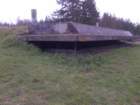
GPMTCP/GCP (Almost 100 photos, all from March 2013 unless otherwise identified.)
This structure was a combined Groupment Command Post (GPMTCP) and a Gun Group Command Post (GCP) which were part of the Harbor Defenses of Puget Sound during WWII. This new underground building was completed and turned over to the Army in July 1943. We have only one document related to this building and only a few contemporary photos, in all cases the exterior of it shows up in the background of something else.
The GPMTCP/GCP was built into a hill over a tunnel between Batteries Ash and Benson. Each Command Post has its own underground room with an Observation Booth in front. The GPMTCP side was protected from a gas attack by an airlock and filters, the GCP side was not. It turned out that the same filtering system, thick walls and earthen cover would provide protection from radiation in the event of a nuclear attack. Almost all the equipment is now gone, the government removed some of it, scrap salvagers and vandals removed more. All that remains are some heating and filtering plumbing, a partial door at the bottom of the stairs, and two interior doors for the airlock. Vandals have also done significant damage to the paneled wall sections and insulated ceiling, as well as some tagging with spray paint. In July 2013 Navy volunteers who were painting over graffiti at Battery Benson next door covered all the graffiti in the GPMTCP/GCP so what you see in the photos is now gone. The primary goal was to cover the graffiti which was multiplying rapidly. It will be repainted soon with the correct color, once we do some testing to determine the original color.
Air Filtration Systems (Four photo albums)
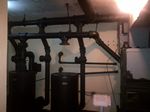
Because of the casualties caused by poison gas attacks in WWI the military took steps to protect critical facilities in WWII in case gas was used again. At Fort Worden 4 structures included gas protection. Two existing structures were modified about 1942, two new structures that were built in 1943 included gas protection in the design. At the time this work was done there was no common knowledge of the dangers of radioactive fallout but it turned out that the steps taken for gas filtering would also remove radioactive contaminates. Since all 4 structures were underground or protected by thick concrete with an earthen cover they would have been relatively safe from blast and radiation too. Click the image at right to view a page with more details about the four buildings with filtration systems.
According to the National Park report cited above:
Gasproofing consisted primarily in sealing an enclosure, and in providing purified air to the inside. The tighter the sealing, the more effective the gasproofing, especially when relief valves were provided for the outward flow of air from the enclosure to the outside. Relief valves were considered an integral part of seacoast defense gasproof installations. Air drawn through the filter of the collective protector unit was blown into the room in sufficient volume to maintain a low positive pressure of about one-eighth of an inch of water. This pressure prevented the entrance of gas-laden air and forced air from the enclosure through the relief valve. An airlock was provided. It served as an entrance chamber where persons who had been exposed to gas might have it removed from their clothing before entering the protected room. Collective protection, in general, was to be installed only in buildings of permanent bombproof or splinterproof construction. The number of persons to be accommodated in any one installation was to be as small as consistent with proper performance of duty.
HECP/HDCP (no photos yet)
The Harbor Entrance Control Post/Harbor Defense Command Post was an underground structure constructed in late 1943 as a joint command Navy/Army (respectively) facility. It was part of the Harbor Defense System of Puget Sound and replaced an above ground building constructed in 1908 which had some of the same purposes.
The intention was to provide a centralized command facility that would identify and control all ship access to the harbors. The Navy section was responsible for detecting, identifying and monitoring passing ships while the Army with their large guns and aircraft was responsible for enforcement. The Coast Guard also provided enforcement. Sometime around the end of WWII the Army and Navy (footnote 1) had pulled out of the HECP-HDCP. The Navy returned in 1951 and manned the facility 24/7 until December 1, 1959 when they closed it up again. It was used as a Navy Reserve Training Facility until sometime in the early 1970s.
When the Navy finally left it was turned over to Washington State Parks to incorporate into the rest of Fort Worden State Park. The Navy actually left quite a bit of material in the building (furniture, cabinets, a large plotting map on the wall, etc.) but within a short time someone broke in and soon the building was accessible to anyone who knew it was there and many people explored it for several years. Most came in to look around, or party in a hidden spot, but a few did extensive damage. After a few years the interior of the building was piled high with trash (including most of the interior partitions) and pathways wound through it.
About 2007 Coast Artillery Museum volunteers secured the building properly and began cleaning it up. Brush and trees were removed from the top of the building and the field in front of it to prevent plant roots from destroying the concrete and to make it accessible. 3,900 pounds of trash was hauled to the dump, much of it the remains of interior walls and furniture that the Navy left behind. The inside of the building was cleaned and painted, wiring was run for modern lights that run off of a portable generator, some air filters from other parts of the Fort were brought in, cleaned, primed, painted and put back in place, and photos were added. CAM will be adding additional displays as time and money permits. The Radar antenna which had been mounted on the roof was recovered from the side of the hill where it had been knocked down some time before and is in the Coast Artillery Museum.
The building is now open for tours from 11 AM to 3 PM on Saturdays in the summer, on some holidays, and by prior arrangement via the museum. Tours are given by volunteers and are free, but donations are always welcome.
More details will be added as I sort photos and put together more information.
1: In mid 2014 we talked with Roy Ridderbusch who served at the HECP in 1951-1953 and again in 1957-1959. Available records are poor at best and we had always thought that the Navy was at the HECP continuously from 1943 to 1959. Roy told us that when he arrived there in 1951 they had to open the place up and do a lot of cleaning and painting since it had been abandoned for several years. With help from Roy we learned several other new facts about the HECP.
Clearing Projects:
Foundations on the 248th Field (22 photos.)

Through most of the period when Fort Worden was an active military base the large field behind the main gun line was used by various reserve units (primarily the National Guard) as a summer campsite when they came out to practice fire the guns, then during times of war these units would be activated to man the guns. The troops would camp in tents in the field, along the eastern edge of the field were 4 Mess Halls and a combined Latrine/Shower building. The last time they were used was around 1940. Eventually the buildings deteriorated and were removed so that all that remained was the foundations. Cracks in the slabs allowed grass and weeds to grow, and on the latrine foundation dirt and debris accumulated which provided rooting for larger plants. Volunteers occasionally cleared 3 of the mess hall foundations, even less often the 4th one which ended up surrounded by trees which grew up at that end of the field. The latrine was probably never cleared. On October 4, 2014 Scout Troop 622 from Bothell Washington came to Fort Worden and cleaned off the foundations. Lots of moss, grass and weeds were scraped off and hauled away. The latrine foundation had accumulated enough dirt to have full size plants growing in it.
GPMTCP/GCP (10 photos, more coming soon.)
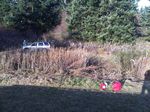
The area around and over the GPMTCP/GCP had gotten seriously overgrown once the top of the hill was effectively abandoned in the mid-1960s. CAM volunteers with the help of some Boy Scout troops cleared some of the vegetation in front of it a few years ago, but because of left over cables laying around the field it couldn't safely be mowed so some of it grew back. In 2011 and 2012 CAM volunteers attacked it again, clearing the areas which had become overrun with invasive plants again, primarily Scotchbroom and Canadian Thistle. Once the area was cleared again we removed the left over communication cables, (some of them armored and over 2 inches in diameter) so that a mower could keep the invasives down. We also mowed the grass (some of it 6 feet high) around the sides and over the top of the GPMTCP. It is now mowed periodically to keep it under control. Because of their proximity, projects at the GPMTCP and Battery Benson often tend to overlap.
Battery Benson (no photos yet)
Once the NIKE Radar unit (see the NIKE display in the Coast Artillery Museum) was removed from the top of Battery Benson the area (like most of the top of the hill) was effectively abandoned and plants and trees were allowed to grow with no control. Quite a few trees had grown up too close to the structure, a few literally within inches. In order to prevent further root damage to the concrete Washington State Parks cut down the critical trees and CAM volunteers are working on removing the down trees. After that the stumps will be ground down so that they aren't in the way of mowers. As part of that cleanup brush within about 10 feet of the Battery was also removed. This will allow occasional mowing of the entire area to prevent invasives and new trees from growing up in that critical area. At the same time CAM volunteers went out into the trees in front of the Battery (and other nearby areas) to kill the ivy that was growing up some of the other trees. Ivy on trees adds a lot of weight (over 2 tons in severe cases) and creates a "sail" that will catch wind and eventually cause the tree to fall.
Battery Putnam (58 photos which still need to be sorted, thinned out and captions added)
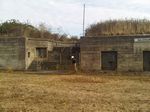
Clearing the area around Battery Putnam started as a painting project, see the separate album in the Painting section. The area behind (opposite the water side) the Battery gets mowed regularly, and occasionally the ground level gutters have been cleaned out. Other than that the area around the Battery has been mostly ignored for many years. Volunteers cleared brush, including lots of Canadian Thistle, Poison Hemlock and Himalayan Blackberry, from the area on top of and around the Battery. We're keeping the flat areas mowed enough to prevent them from growing back, and using a brush hog and weed eaters on the slopes to keep them under control.
One scene in An Officer and A Gentleman was filmed in the gun pit and then along the back of Battery Putnam. Watch for the black metal doors with hand painted numbers on them.
Photo album will be cleaned up soon.
Battery Stoddard (no photo album yet)
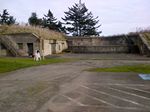
Clearing brush and invasives around Battery Stoddard morphed out of the Battery Putnam projects because they share a common hillside. The area between the two Batteries was seriously overgrown with rose thickets, and a lot of poison hemlock was growing up out of that. One of the primary goals was to control the poison hemlock, but also to protect the Battery by keeping the brush away from it.
In clearing the area between the two Batteries we came across a concrete pedestal that was a surprise to us. Once we knew to look for it we could see a small building at that location in old aerial photos, but we still haven't found any records to tell us what it is. The pedestal is typical of a spotting scope mount, but that's just a best guess at this point.
Rothschild House (no photos yet)
Rothschild House is another State Park in Port Townsend. It's a single house built in 1868 on a double lot on the hill overlooking Port Townsend Bay, and is maintained as it was in the early 1900s. The terrace on the hillside had become totally overgrown with ivy and CAM volunteers helped
Gray Wolf Ranch workers clear most of it in a 2 day work session in April 2013.
Photos coming soon.
Painting projects:
Battery Walker (39 photos)
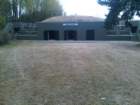
While clearing brush off the top of Battery Walker in late summer of 2012 we decided that the easiest way to cover up the graffiti was to simply paint the entire Battery. So in addition to clearing around it to protect it from physical damage, we painted it. The exterior colors have been restored to the original green concrete and black doors that would have been what it looked like right after it was constructed in 1907. The interiors of the three rooms still have a lot of graffiti in them, and we hope to paint them over someday too. One room is closed up because it is used for storage of some old steel doors from other parts of the Fort.
Battery Putnam (no photos yet)
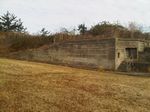
After Battery Walker was painted, State Parks asked if we would consider painting Battery Putnam. Walker is on the far end of Artillery Hill and only accessible on foot in most cases, Putnam is right down on the main campus of the Fort. To paint it, a lot of prep work was required. A crew from AmeriCorp helped us for parts of two days and did brush removal along the bottom of the walls, a lot of scraping to remove moss and dirt, along with starting the painting. Washington State Parks bought some of the paint, CAM bought the rest. Battery Putnam (not counting the wing walls) is the same size as Battery Walker, but took a lot more paint. We used about 13 gallons on Putnam compared to 8 at Walker. Some of that difference is due to the larger wing walls, but the condition of the concrete was the major factor.
Mortar Battery Powerhouse (17 photos of before and during the painting, "after" photos will be added when I find them, they're around here somewhere.)
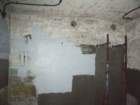
In the fall of 2011 two local men agreed to help paint over some graffiti inside the generator building below the Mortar Batteries. They bought some paint and CAM provided the rest. The powerhouse was repainted in the original early 1900 colors which was a dark green on the lower part of the walls and white on the upper section and ceiling. We didn't work on the ceiling because of the condition of the paint, but the walls were primed and painted. Because the building was used by the Army in WWII it had a light blue stripe between the green and white sections, traces of that are still in some of the corners.
Unfortunately some graffiti artists hit the building again with some extremely large art, which we've partially painted over, but two walls will need to be repainted.
Battery Benson (no photos yet)
Part of Battery Benson has been tagged pretty heavily because it's so isolated and screened from observation. In June of 2013 some Navy personnel from Naval Station Bremerton had enough, and stopped by the Museum to offer some help. In July 2013 about 15 Navy volunteers spent a day painting Pit 1 and the hallway between the gun pits to cover the graffiti. The paint matches the original color of the Battery from 1907. At the same time the Navy volunteers painted over all the graffiti on the interior of the GPMTCP/GCP in the hill to the east of Battery Benson because it had even more graffiti. The graffiti is covered but we still need to determine the original color of that structure and repaint it. In August 2013 CAM volunteers and Military Vehicle Show participants cleared enough of the slope behind the Battery to allow it to be visible from the top of the hill, making it easier to spot taggers at work.
1 SPECIAL HISTORY STUDY, FORT MOULTRIE HECP-HDCP, FORT SUMTER NATIONAL MONUMENT, SOUTH CAROLINA, Prepared by Edwin C. Bearss, Denver Service Center Historic Preservation Team, National Park Service in May 1974. You may download several different versions of the book including PDF and e-reader from
Archive.org.


Puget Sound Coast Artillery Museum
Building 201
Fort Worden
200 Battery Way
Port Townsend, WA 98368
(360) 385-0373
Privacy Policy: This site collects no personal information about it's visitors.
Copyright 2011-2013 by the Puget Sound Coast Artillery Museum
Page Revised November 02, 2014










